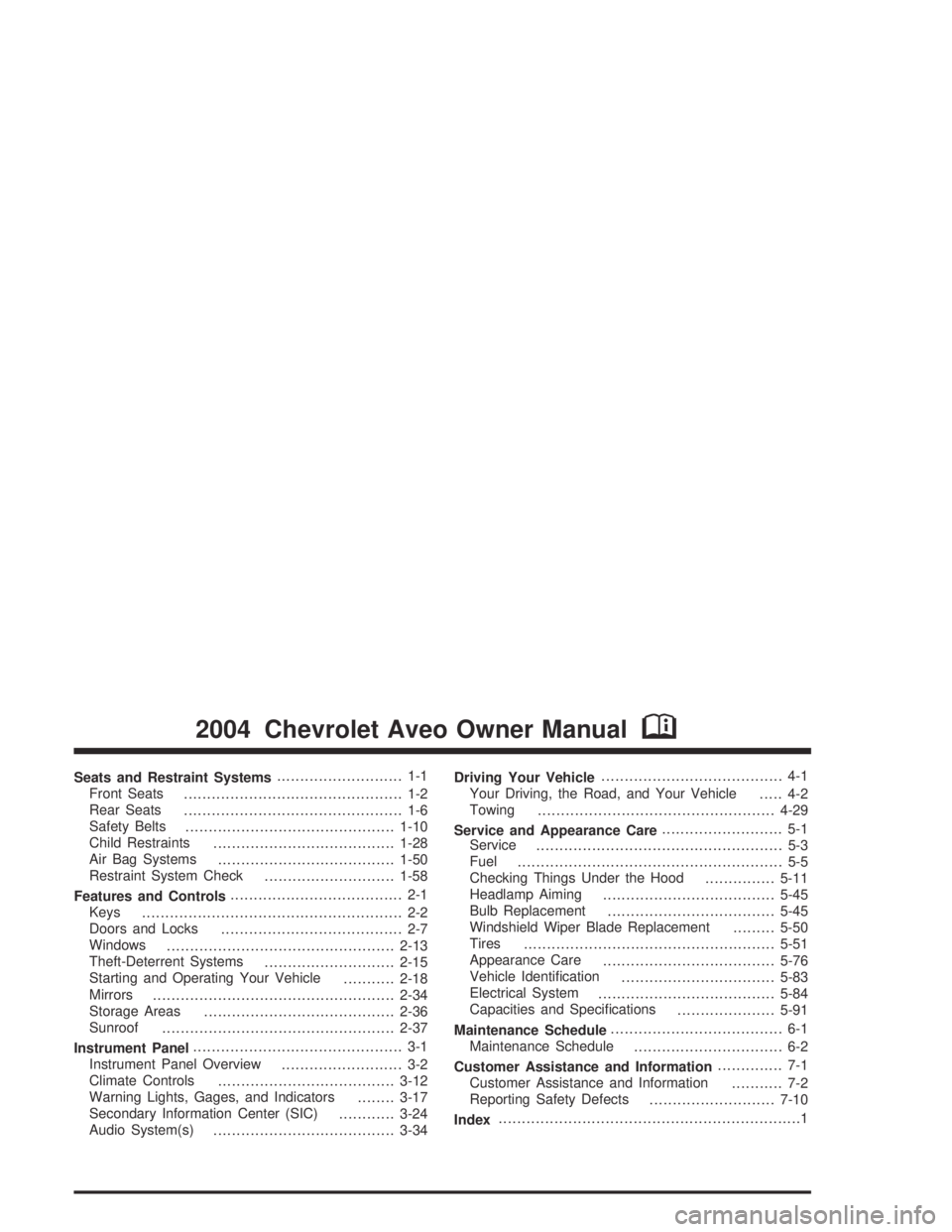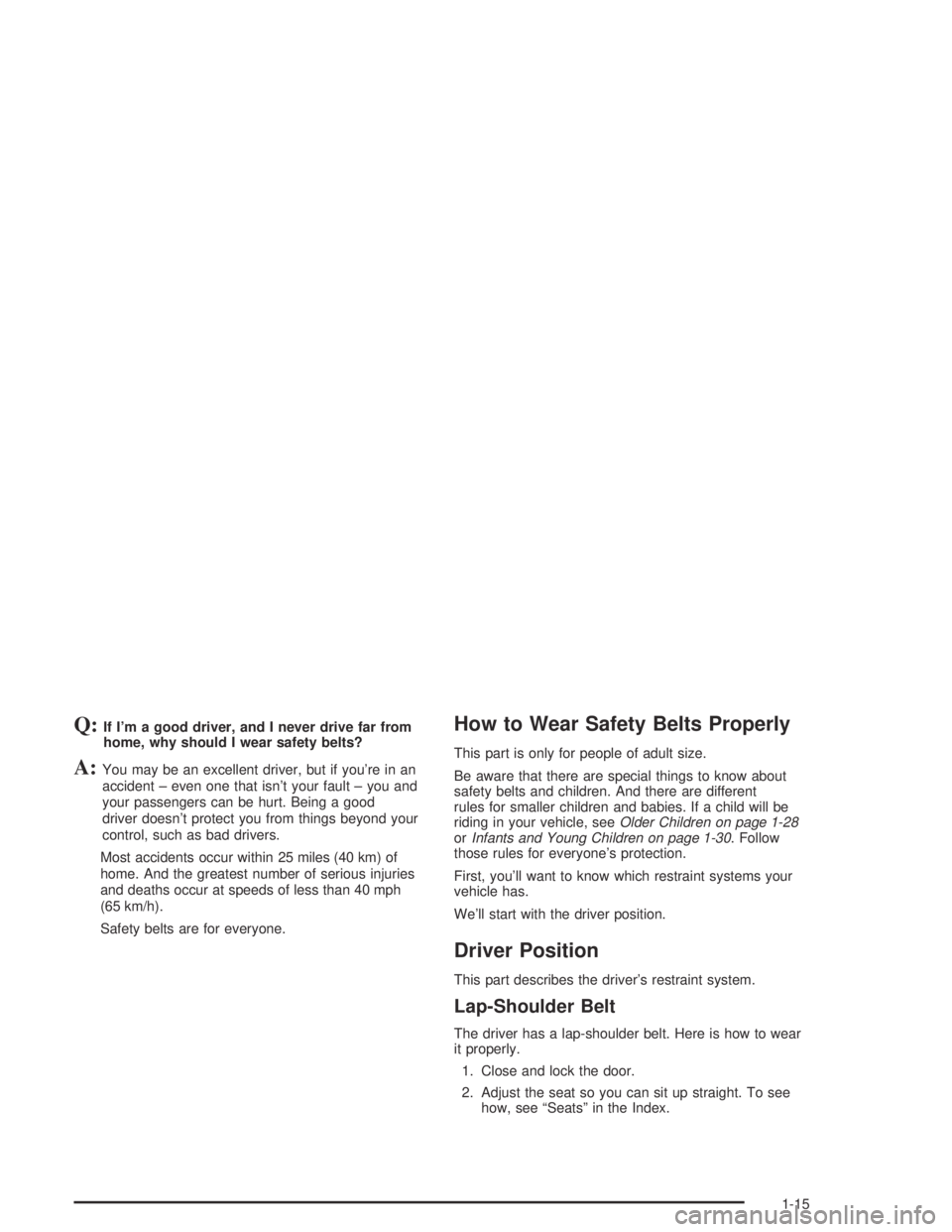Page 1444 of 5127

Seats and Restraint Systems........................... 1-1
Front Seats
............................................... 1-2
Rear Seats
............................................... 1-6
Safety Belts
.............................................1-10
Child Restraints
.......................................1-28
Air Bag Systems
......................................1-50
Restraint System Check
............................1-58
Features and Controls..................................... 2-1
Keys
........................................................ 2-2
Doors and Locks
....................................... 2-7
Windows
.................................................2-13
Theft-Deterrent Systems
............................2-15
Starting and Operating Your Vehicle
...........2-18
Mirrors
....................................................2-34
Storage Areas
.........................................2-36
Sunroof
..................................................2-37
Instrument Panel............................................. 3-1
Instrument Panel Overview
.......................... 3-2
Climate Controls
......................................3-12
Warning Lights, Gages, and Indicators
........3-17
Secondary Information Center (SIC)
............3-24
Audio System(s)
.......................................3-34Driving Your Vehicle....................................... 4-1
Your Driving, the Road, and Your Vehicle
..... 4-2
Towing
...................................................4-29
Service and Appearance Care.......................... 5-1
Service
..................................................... 5-3
Fuel
......................................................... 5-5
Checking Things Under the Hood
...............5-11
Headlamp Aiming
.....................................5-45
Bulb Replacement
....................................5-45
Windshield Wiper Blade Replacement
.........5-50
Tires
......................................................5-51
Appearance Care
.....................................5-76
Vehicle Identification
.................................5-83
Electrical System
......................................5-84
Capacities and Specifications
.....................5-91
Maintenance Schedule..................................... 6-1
Maintenance Schedule
................................ 6-2
Customer Assistance and Information.............. 7-1
Customer Assistance and Information
........... 7-2
Reporting Safety Defects
...........................7-10
Index.................................................................1
2004 Chevrolet Aveo Owner ManualM
Page 1451 of 5127
Front Seats
Manual Seats
{CAUTION:
You can lose control of the vehicle if you try to
adjust a manual driver’s seat while the vehicle
is moving. The sudden movement could startle
and confuse you, or make you push a pedal
when you don’t want to. Adjust the driver’s
seat only when the vehicle is not moving.Pull up and hold the bar
located under the front of
the seat to unlock it.
Slide the seat to where you want it and release the bar.
Then try to move the seat with your body, to make
sure the seat is locked into place.
1-2
Page 1452 of 5127
Driver Seat Height Adjuster
To adjust the height of
the driver’s seat cushion,
turn the knob located
on the outboard side of the
seat cushion.
Turn the knob forward to raise the height of the seat
cushion and rearward to lower it.
Reclining Seatbacks
To adjust the seatback, pull up the lever located on the
outboard side of the seat and move the seatback to
where you want it.
Release the lever and push rearward on the seatback
to make sure it is locked.
1-3
Page 1455 of 5127
Rear Seats
Rear Seat Operation (Hatchback)
Folding the Seatback
The rear seatbacks can be folded down to increase
cargo space.
To fold down the seatback, do the following:
1. If your vehicle has adjustable head restraints,
push the head restraints down all the way.
2. Pull up the release knob located on top of the rear
seatback.3. Fold the rear seatback forward and down.
4. Move the safety belts and safety belt buckles out of
the space between the seatback and the seatback
cushion.
5. Pull the release handles on the rear side of the seat
cushion to unlock the rear seat cushion.
6. Lift and fold up the seat.
1-6
Page 1456 of 5127
7. Clip the hook to the head restraint of the front seat
to keep the rear seat secure.
8. Store the rear safety belts and buckles in the
storage area under the floor mat.
{CAUTION:
If the seatback isn’t locked, it could move
forward in a sudden stop or crash. That could
cause injury to the person sitting there. Always
press rearward on the seatback to be sure it is
locked.
{CAUTION:
A safety belt that is improperly routed, not
properly attached, or twisted won’t provide
the protection needed in a crash. The person
wearing the belt could be seriously injured.
After raising the rear seatback, always check
to be sure that the safety belts are properly
routed and attached, and are not twisted.
1-7
Page 1458 of 5127
{CAUTION:
If the seatback isn’t locked, it could move
forward in a sudden stop or crash. That could
cause injury to the person sitting there. Always
press rearward on the seatback to be sure it is
locked.
{CAUTION:
A safety belt that is improperly routed, not
properly attached, or twisted won’t provide
the protection needed in a crash. The person
wearing the belt could be seriously injured.
After raising the rear seatback, always check
to be sure that the safety belts are properly
routed and attached, and are not twisted.To return the seatback to the upright position, do the
following:
1. Lift up the seatback and push it to its original
position. Ensure that the safety belts are not twisted
or caught under the seatback.
2. Push down firmly on the top of the seatback until it
latches securely in the fully upright position.
1-9
Page 1464 of 5127

Q:If I’m a good driver, and I never drive far from
home, why should I wear safety belts?
A:You may be an excellent driver, but if you’re in an
accident – even one that isn’t your fault – you and
your passengers can be hurt. Being a good
driver doesn’t protect you from things beyond your
control, such as bad drivers.
Most accidents occur within 25 miles (40 km) of
home. And the greatest number of serious injuries
and deaths occur at speeds of less than 40 mph
(65 km/h).
Safety belts are for everyone.
How to Wear Safety Belts Properly
This part is only for people of adult size.
Be aware that there are special things to know about
safety belts and children. And there are different
rules for smaller children and babies. If a child will be
riding in your vehicle, seeOlder Children on page 1-28
orInfants and Young Children on page 1-30. Follow
those rules for everyone’s protection.
First, you’ll want to know which restraint systems your
vehicle has.
We’ll start with the driver position.
Driver Position
This part describes the driver’s restraint system.
Lap-Shoulder Belt
The driver has a lap-shoulder belt. Here is how to wear
it properly.
1. Close and lock the door.
2. Adjust the seat so you can sit up straight. To see
how, see “Seats” in the Index.
1-15
Page 1465 of 5127
3. Pick up the latch plate and pull the belt across you.
Do not let it get twisted.
The shoulder belt may lock if you pull the belt
across you very quickly. If this happens, let the belt
go back slightly to unlock it. Then pull the belt
across you more slowly.4. Push the latch plate into the buckle until it clicks.
Pull up on the latch plate to make sure it is secure.
Make sure the release button on the buckle is
positioned so you would be able to unbuckle the
safety belt quickly if you ever had to.
5. To make the lap part tight, pull down on the buckle
end of the belt as you pull up on the shoulder belt.
1-16